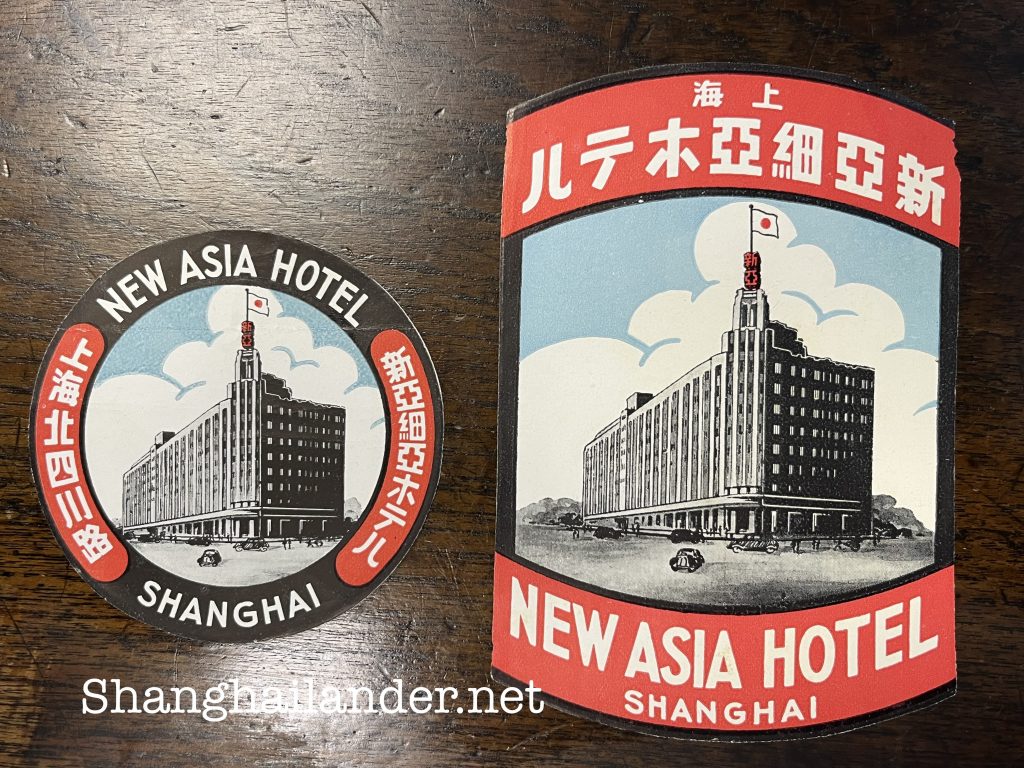Search about New Asia Hotel continued after the original post “New Asia Hotel“. Not much seem to have been written in English about it, probably due to its off side location in Hongkou (Hongkew in old spelling) district and its short original life from 1932 to 1937 (before being taken by the Japanese authorities). My original post “New Asia Hotel” attracted attention from fellow researchers, who shared the information with us.
First of all, the original post showed one example of label, but I found another one. Style is very similar but this one is round, compared to the original with slightly different shape. The round shape is also smaller, with different font used though design is very similar.

Luggage labels were is fashion in luxury hotels, and New Asia Hotel was one of the many hotels in Shanghai. More Old Shanghai luggage labels are displayed on post “Old Shanghai luggage labels” as well as “More Old Shanghai luggage labels“.
Peter Hibbard, who has researched the Cathay Hotel and wrote a book about it (See post “Peace at the Cathay“) gave a lot of information of the original mission of the New Asia Hotel.
” The New Asia deserves special mention as it was a remarkable diversion from other ‘modern’ Chinese hotels. Before the Japanese arrived the hotel was a moral exemplar. The New Asia Hotel decided to break away from the prevailing standards of Chinese hotels by barring mahjong, women of ill-fame and opium. With branches of the hotel already operating in Hong Kong and Canton, the nine storey Shanghai hotel, situated on the corner of Tiendong and North Szechuen opened in January 1934. The aim of the Cantonese general manager, Mr. Cheng Bew, known to foreigners as Mr. B Jones, was to conduct business along the lines of the foreign hotels where the morals of young men may be preserved and where the charges will be within reasonable reach of the average man’s pocket.
The unusual combination of Christian fellowship and sound business practice brought, to the surprise of many, immediate and lasting success. In it’s first year of operation the hotel received over 72,000 guests. All of the hotel’s 450 staff were meticulously trained in the hotel’s own lecture rooms, with many of them being able to speak English.
The hotel company, in deliberately omitting a ballroom from the hotel, substituted a spacious roof garden for healthy recreation and games. However a small bar was to be found on the ground floor near a club-like lounge and reading room. The hotel invited international patronage, with the Chinese and foreign dining rooms being a favourite lunchtime haunt of Shanghai’s diplomatic circle. “
Peter also added specific information about the drastic change of policy after the takeover by the Japanese authorities.
“The China Weekly Review May 28th, 1938:
Christian Hotel Converted into den of intrigue…
The New Asia Hotel …has been diverted to strange usage, so strange as to verge on the occult if one would believe all the stories told about the hostelry.
When opened it announced that it would be ‘operated in strict accordance with Christian principles,’ in sharp contrast to some other hotels in the city which catered to ‘the flesh and the devil.’ It had Gideon bibles in every room and was the first ‘strictly modern’ Chinese hotel in Shanghai.
When the Japanese seized the Hongkew area, the Special Service section grabbed the New Asia and established its headquarters there. For a time it was operated by foreigners but now totally Japanese. Now serves as headquarters for around 30 different ‘puppet organisations.’ The New Asia is a hotbed of traitorous activity, housing all manner of organisations which the Japanese warlords are using fro breaking down Chinese resistance or misleading or confusing the public as to what really is going on.’
Secret agents of the organizations are sent into the International Settlement and the French Concession to solicit members. They are plentifully supplied with funds and their main purpose is to invite the prospect to the New Asia for a feat and party. Many Chinese newspapers carried stories of nightly orgies.”
After WW2, the hotel continued being used by the military.
” The China Daily Tribune 3.3.48
Air Transport under General Chennault – the Flying Tigers, moved into New Asia Hotel after V-J Day, later occupied by the US Army and then the Army Advisory Group in 1948.”
Finally, the building was designed architect S. A. Sayer, but American Chinese architect Poy Gum Lee (See post ” Poy Gum Lee lost building“) was also involved as a consultant. He was a rumored to be the actual designer but denied in a new paper post. He retained shares of the hotel after he returned to New York.